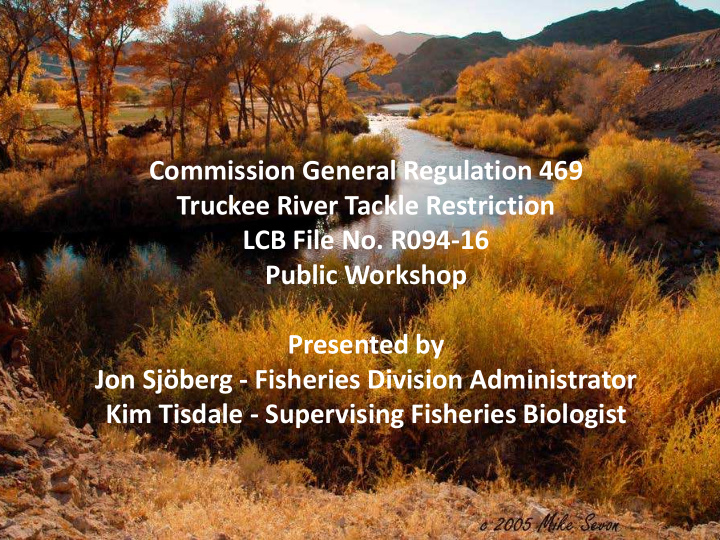



Commission General Regulation 469 Truckee River Tackle Restriction LCB File No. R094-16 Public Workshop Presented by Jon Sjöberg - Fisheries Division Administrator Kim Tisdale - Supervising Fisheries Biologist
Proposed Regulation Change • The Department is proposing an amendment to NAC 503.504 to require the use of certain types of fishing tackle in portions of the Truckee River. Only artificial lures with single barbless hooks may be used on the Truckee River from 1,000 feet downstream of Derby Dam to the Pyramid Lake Paiute Reservation boundary from February 1 through May 31 • Objective: to reduce incidental mortality of spawning adult Lahontan cutthroat trout due to angling.
Process Overview • First step in developing the following proposed regulation for 2017: – Open year around, any hour of the day or night, except in that portion which is 1,000 feet downstream of Derby Dam, which is closed to fishing. Limit is 3 game fish except that portion 1,000 feet downstream of Derby Dam to the boundary of the Pyramid Lake Indian Reservation, only 3 game fish of which zero (0) may be trout (catch and release only) using only artificial lures with single barbless hooks from February 1 through May 31. • Two-part process: – CGR – Changes to NAC tackle restrictions • requires 2 workshops – CR – “Season and Bag” at September NBWC Meeting • CR 16-02 Amendment to establish a zero limit on trout from 2/1- 5/31
Background • 2015 MOU between NDOW, USFWS and PLPT – Work together towards restoring LCT to Truckee River by re-establishing a natural run of LCT – To utilize LCT in the maintenance of the Truckee River recreational fishery. • Agency Authorities: – PLPT manages fishery on PLPT Reservation – NDOW manages fishery in Nevada – USFWS administers Endangered Species Act • Cui-ui – endangered species • LCT – threatened species
History of Pilot Peak LCT • LCT extirpated from Pyramid Lake by 1944 • Nevada Fish and Game and PLPT initiated reestablishment of LCT into Pyramid Lake in the early 1950s using LCT stocks from Walker, Independence and Summit lakes • Pilot Peak strain discovered on NV/UT border in the late ‘70s and genetic analysis in 80’s and 90’s determined the fish originated from the original Pyramid Lake stock. • In 1995, USFWS began culturing these fish at the Lahontan National Fish Hatchery in Gardnerville. • In 2006, began stocking Pilot Peak LCT into Pyramid Lake in cooperation with Pyramid Lake Paiute Tribe
Fast forward 10 years … Photo Credit Doug Ouellette
Marble Bluff Fish Facility Photo Credit USFWS Photo Credit USFWS Photo Credit USFWS
Marble Bluff Fish Facility 485 Pilot Peak LCT passed above Marble Bluff in 2016 • The 501-550mm (19.7-21.6”) fish represent the age class • stocked in 2010 when USFWS increased stocking efforts Largest fish processed at MBFF was 19 lbs, 34 inches • Largest fish documented in creel was 26 lbs, 36 inches •
Spawning Activity below MBFF Photo Credit USFWS USFWS biologist measuring a spawning redd Photo Credit USFWS
Numana Dam Located 12.5 miles • upstream of Pyramid Lake Includes functional fish • ladder. USFWS and PLPT plan to • allow passage in 2017. Would open up 27 • additional miles of spawning habitat.
Derby Dam Located 39.5 miles • upstream of Pyramid Lake Constructed in 1905 • Complete fish passage • barrier Includes fish bypass channel constructed in 2002 • but has not been operational due to lack of fish screen on Derby Canal. Passage around Derby Dam may be possible in the • future if screen is built.
Conclusion As water conditions in Pyramid Lake and fish passage in the Truckee River • have improved, increasing number of LCT are anticipated to migrate into the Truckee during the spawning season. Special regulations are being proposed to reduce harvest and incidental • mortality of spawning adult LCT resulting from angling – CGR 469 (tackle restriction): minimizes handling and makes hook removal easier. Reduced mortality. – CR 16-02 Amendment (zero limit from 2/1-5/31): Limits harvest of trout; allows for angling opportunity without inhibiting spawning activity. Anglers benefit from the regulation as it will preclude the need for • seasonal closure, allowing catch and release fishing for trout and continued harvest of other sport fish species. LCT would have increased opportunity to spawn and their progeny would • enhance resident population in the lower river, contributing to recovery efforts and increasing angler opportunity in a section of the river that receives very little use.
Questions?
Recommend
More recommend